Category Archive for Nightcrawling
Tokyo Goth clubs & absinthe bars! Gothic party Midnight Mess, Decabar Z, Japanese tribal tattoos.

Greetings from the red torii gate of Hibiya Shrine! Ready for more alternative travel tips from Japan?
I haven’t posted any updates recently to my Tokyo Goth clubbing guide, so keep reading for the latest party / nightclub information, as well as a peek inside an absinthe bar.
I’ll also take you to two Godzilla statues, and an exhibit of Japanese modern primitive tattoos with Keroppy Maeda (who did the infamous bagelheads for our TV shows).

I receive far too many emails from travelers, asking for information about Japanese Goth and Alternative parties / clubs. It’s impossible for me to look up specific information for everyone, so here’s what I encourage you to do:
1 – Consult my Tokyo Goth clubbing guide, which highlights parties and events from over the years.
2 – If you’re reading this post in 2017, I suggest you check out the Facebook pages of Midnight Mess, Decabar Z and Department H. Upcoming parties will be announced there, usually about a month in advance. There are also smaller and less frequent alternative / Goth parties, but it’s impossible for me look up everything for each person, as I’m sure you can understand.
So again, please check out this club guide and research the party names I mention there, to see if they have any upcoming events. I hope you have a great time!

We’ll delve deeper into the nightlife further down in this post. But let’s start with a visit to Hibiya Jinja in Minato-ku, by Park Hotel Tokyo (where we stayed).
Outfit details: My sunglasses are these exact ones. I paired fishnet tights with my leopard print dress, which is Gladnews Japan (it’s available for sale on my Depop).

Although it’s now surrounded by busy streets, this peaceful Shinto shrine dates back 400 years. I smiled at the statues of fox spirits, and washed my hands in the running water of this purification fountain.

Ring my bell-el-el. I’m tugging a rope that leads to a “suzu” or Japanese Shinto bell that contains pellets. The ringing sound calls the kami, or spirits, which brings in good fortune and positive energy.

Kitsune (foxes) are prominent in Shinto folklore. They’re messenger spirits to Inari, as you’ll recall from my visit to the famous shrine of Fushimi Inari in Kyoto.

There’s another creature who has a big impact on the Japanese imagination… ‘Gojira’!
I walked to the Godzilla Statue in Ginza, which is located next to Toho Cinemas (as they release all the Godzilla films). (Address: 1 Chome-2-2 Yurakucho, Tokyo)

Shin-Godzilla or Godzilla Resurgence was still playing in the theater when we visited.
The nearby mall even had a Godzilla-themed cafe with food that was shaped like the monster’s paw! (For more about Tokyo theme restaurants, check out my book.)

I’m wearing these exact Vysen lavender sunglasses and this Shashi Tiffany choker necklace.
This little Godzilla statue is based on one of the older movie designs, and doesn’t seem so frightening. But inside the mall…

… there’s a much bigger and scarier Godzilla! This is the latest look for the “dai kaiju”, as seen in the new movie.

We saw a lot of fans come to take photos with the towering Godzilla statue (he’s so popular here). This was only a temporary pop-up so I don’t think this statue is here any more.
His little eyes and pointy teeth are a bit goofy when seen from up close….

If you’re a fan of the Japanese monster, you’ve got to stay at the Godzilla head hotel in Shinjuku like we did. Don’t miss these photos of our stay in the Godzilla Gracery Hotel.

One evening, I supported my friends John and Keroppy at their panel discussion on Japanese tribal tattooing at TAV Gallery in Asagaya. This small but progressive space showcases artists who are involved in alternative culture. (Gallery address: 阿佐谷北1-31-2 Suginami-ku, Tokyo, Japan)

John Skutlin, a cultural anthropologist who specialises in the study of Japanese tattooing and body modifications, speaks about the experience:
“On display at the TAV Gallery that night were photos from the Jōmon Tattoo Project, a collaboration between journalist and photographer Keroppy Maeda and black-work tattooist Taku Ōshima that attempts to recreate the tattoos of Japan’s Jōmon period (approx. 14,000~300 BCE) on modern human bodies.”

“Although there is no physical evidence of tattooed bodies from the Jōmon era, the people of that period left behind clay figurines called dogū, which depict human forms engraved with various swirling and spiraling designs that archaeologists theorize to represent scarification and tattooing. Chinese accounts from the second and third centuries CE record extensive tattooing among the people of the Japanese archipelago, making it even more likely that the Jōmon people had a rich tradition of tattooing,” says John.

The discussion held that evening included Maeda and Ōshima, as well as the Miho Kawasaki (chief editor of Tattoo Burst magazine from 1999-2012), Professor of New Materials and Technologies Werner Lorke (HfG Offenbach, Germany), and cultural anthropologist John M. Skutlin (The Chinese University of Hong Kong).
Subjects included the inspiration behind the project and speculation as to what kind of role tattooing played among the Jōmon people. Maeda believes that the urge to alter one’s body is universal, saying that, in the course of our evolution, “the first step to becoming a human being is the choice to change our own bodies artificially.”

John continues: “According to the project’s manifesto, the Jōmon tattoos are “inscribed upon real human bodies as modern tattoo designs to show how the primitive spirit of humankind will become a new identity to survive the postmodern life of the 21st century.” Ōshima, who spent time studying tattooing in Goa, India before traveling the world to ply his trade, is a master of bold black-work designs, many of which cover entire arms, legs, and bodies.”

“Nearly all of the volunteers for the project had never been tattooed before, and the striking designs indicate natural phenomena that would have been important to the tribal peoples of ancient Japan. Waves, snake coils, and tree branches are all motifs that can be seen in the designs of dogū and now recreated on the bodies of the project participants. “You could say that Jōmon tattooing is the true traditional tattooing of Japan, and the designs everyone knows from the Edo period [1603-1868] were Japan’s modern tattooing,” said Ōshima.

For more about John Skutlin’s research, you can read his interview with The Diplomat and watch his presentation at the University of Pittsburgh about ink and body modifications in Japan.
If you’re in Frankfurt, Germany between June 3-18, you can see the Jomon Tribe exhibition at Robert Mayer Zeigt Galerie. I’m excited to see how the modern primitive movement in Japan will continue to develop, and question the country’s taboos about tattooing.

While in Tokyo, John and I were also guests at Midnight Mess, the longest-running Goth club — and our hangout for a decade now! How time flies…
If you’re coming to Japan, I highly recommend that you check out their Facebook group page for upcoming events. DJ Maya always creates a welcoming space (and she and many of the guests speak English).

We gathered at Bar Shifty in Shibuya for the all-night party. Under the disco ball, Goths in black clothing danced to EBM, dark techno / electro, industrial, aggrotech and noise.

Posing with Athena, who often plays with Mistress Maya in shibari (rope-bondage) performances.

It was great to reunite with Maya and DJ Statik, the resident deejay who I’ve known for years.

As always, the party ran all night long (trains stop running in Japan after about midnight or 1am — so you have to keep on dancing til dawn!)

Midnight Mess always brings in underground performers and guests from around the world. That evening, DJ Maschinenpriester from Germany pounded out a special set.

I also invite you to visit Mistress Maya at her Gothic/Fetish Bar, which takes place every Monday & Tuesday at Grenier (a small snack bar in the gay district of Shinjuku). She’ll play alternative music, and make sure you are well fed with homestyle cooking and drinks. Address: 東京都新宿区新宿2-18-10 新千鳥街二階 (2-18-10 Ni-Choome, Shinjuku, Tokyo), phone 0363801199.

DJ Sin performed with a hooded head. (All of these club photos are by fake-fantasy).
Thanks to Midnight Mess for having us as the guests of honor!

My friends and I also stopped by one of our favorite Goth bars — Guinea Pig in Kabukicho, Shinjuku. I previously wrote about this bizarre horror bar here. The bondage baby and spine immediately set the dark (yet fun) mood of this tiny bar.
Address: 2-41-2 Leo Kotobuki Building 3-A, Kabukicho, Shinjuku, Tokyo. 1000 yen cover. Opening hours are generally 8pm to early morning. Phone: 03-3209-3455

There’s always an eccentric crowd of regulars sitting around the long, black bar. Yes, that’s a blood-splattered pole in the middle — and torture instruments in the back.

We love coming here to sit under the rotting flesh cross, and watch splatter-gore movies play on the big screen.

Obviously, Guinea Pig is not a bar for everyone. But if you love strange, obscure, weird Japan — this spot is for you.

Chains and zombie hands and live snakes — yes please.

Even though I am in Tokyo all the time, the city and subculture never grow old to me.

Guinea Pig caters to horror / experimental / slasher movie fans. When we visited, they were showing trailers from Herschell Gordon Lewis films (such as Two Thousand Maniacs and Blood Feast), as he had died that week.

Cheers to Guinea Pig, which remains one of our regular drinking holes! If you’re interested in Tokyo Visual Kei and Jrock bars, a Suspiria themed bar, and other oddities, check out my Tokyo nightlife guide.

Close-up on Atsushi’s spiked fang ring and studded bracelets. Now, to the next party…

There’s something about Shinjuku at night — lit up and buzzing — that fills me with joy, every single time I’m here.

Every time we’re in Tokyo, we stop to see our friends at Decabar Z (5F Shinko Building, 1-2-13 Kabukicho, Shinjuku-ku, Tokyo, Japan. Here’s a link to the map.)
John’s pentagram top is by Disturbia Clothing, makers of occult and Satanic fashion.

Tokyo’s alternative DJs, performers and personalities grace the colorful mural at the entrance of Deca Bar Z. Here’s Maya as a cat, offering a cup of sake in a pink kimono.

Devil horns to match this Satanic ouija board unisex shirt, by Disturbia.

Say hello to Preta Porco, who you’ll find behind the (Deca) bar! He’s easy to spot with his bright yellow foundation, contrasted with rosy red lips and cheeks.

Adrien le Danois, owner of Deca Bar Z, also runs the Tokyo Decadance parties. If you’re not in town during one of the decadence events, don’t fret — Decabar Z is open every evening, and there are always interesting theme nights such as “Addams Family.”

Grab a glass of absinthe, and chill out on the comfortable couches. (Here are more photos of Deca Bar Shinjuku, from my last visit.)

We loved the music at the “I Am Electro” night, run by Migon. The DJs play Depeche Mode, Visage, Europe and other favorites — as well as obscure synthwave and 1980s Goth.

As an absinthe aficionado, I’m always looking for the green fairy wherever I go.
Maya took me to Caribbean, an absinthe and rock bar in Kabukicho. (Address: Kabukicho 1-3-10 2F, Shinjuku Tokyo)

I drank Mansinthe (Marilyn Manson’s absinthe) and we chatted with the owner. He let DJ Maya control the song selection, resulting in the perfect Goth playlist.

The same owners also run the nearby Absinthe Bar Alternative (Address: 1-6-12-B1F, Kabukicho 歌舞伎町, Shinjuku-ku, Tokyo 160-0021). It’s a small basement bar, with several shelves of absinth from around the world — heavenly.

If you’re looking for more absinthe in Tokyo, check out Bar Tram in Ebisu.
Modern primitive tattoos, spatter-gore bars, Gothic club nights… isn’t Tokyo’s underground the best? For more coverage of Japanese alternative nightlife, come peruse my Tokyo Goth club guide. Have fun!
SHARE & COMMENT
Volunteering with Punk Rock bands in Yangon, Myanmar! The Rebel Riot, Human Rights concert, Rangoon restaurants.

Believe it or not — there’s a 1970s-style punk rock subculture in Myanmar!
Yukiro and I loved getting to know Kyaw Kyaw, the leader of Burmese punk band Rebel Riot, and his studded, tattooed, Mohawk-ed friends.
As you’ll see in this post, Yangon’s punks play hard. But they also give back to their community in a huge way: Kyaw Kyaw runs two charities that directly aid the homeless, and children in need.
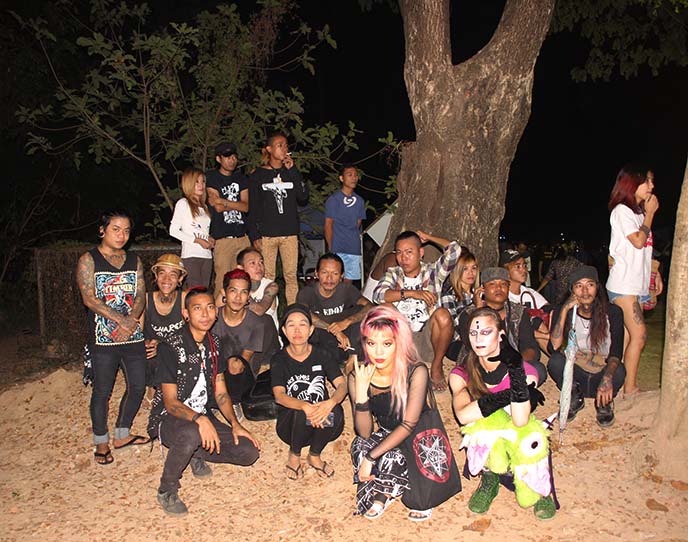
Yukiro and I called the theme of our Burma trip “Monks and Punks.” The two groups have more in common than you’d think: they’re all about inclusivity, compassion, and taking action to support others.
(You might remember from our Shwedagon Pagoda photos that this is the world’s most Buddhist nation.)

Before we arrived in Yangon, I reached out to The Rebel Riot band on Facebook (as they are one of the most prominent punk groups in the scene). We were keen to volunteer for their charities, and get to know Burma’s alternative, underground side.
Singer and songwriter Kyaw Kyaw welcomed us warmly. He invited us to Human Rights Day, where The Rebel Riot was performing an acoustic set.
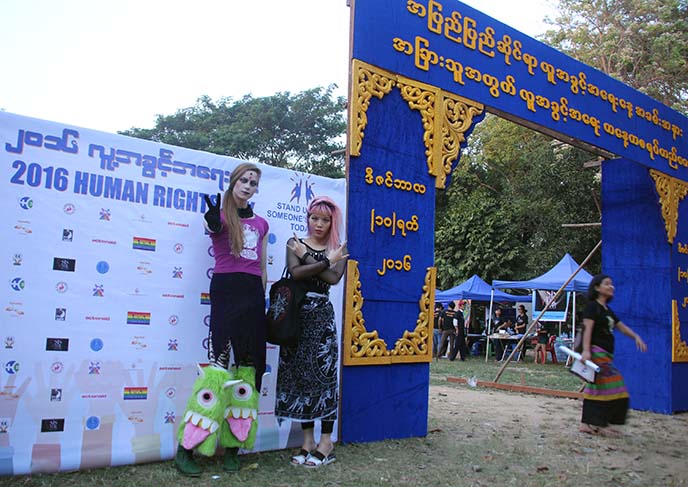
The free event took place outdoors, in People’s Park (not far from the famous golden temple).
As I mentioned in my first post about Myanmar, the country was formerly under a military dictatorship, which put up strict barriers for freedom of expression. The state of human rights is still a work in progress here (as it is everywhere — I’m not going to get into the specific politics). Still, it’s significant to have event like this one, run by young Burmese who believe in this mission.
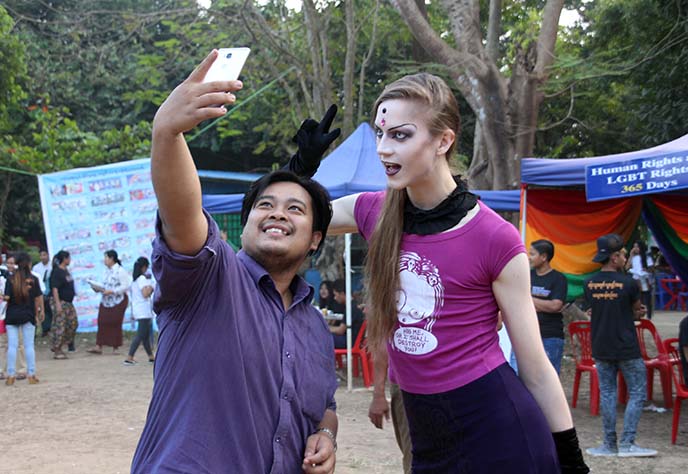
We were thrilled to meet locals at the event. I was impressed by their passion: they were here to stand up and speak out, for human equality and freedoms.
A lot of friendly faces came up to us, and asked to take photos together. Yukiro’s makeup and fashion were quite the sensation!
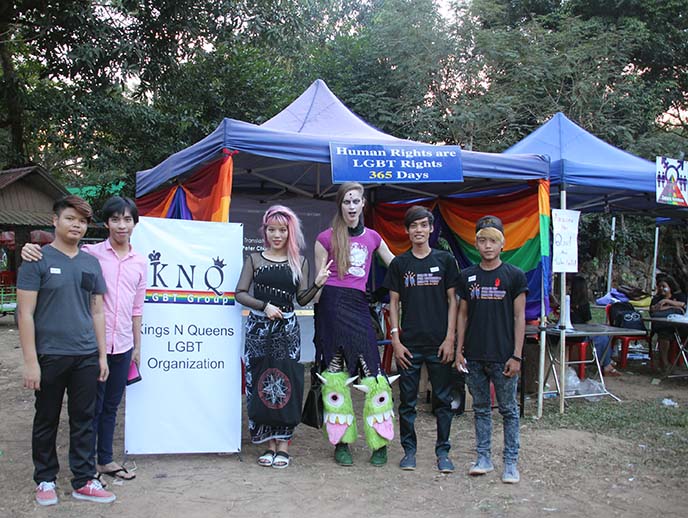
In recent years, the LGBT community has become more open and accepted in Myanmar. Still, same sex activity remains technically illegal, and the gay night at J-One Music Bar is sometimes shut down.
The King n Queens Organisation is doing wonderful work to advocate for equality in Burma. As their motto says, “Human rights are LGBT rights.”
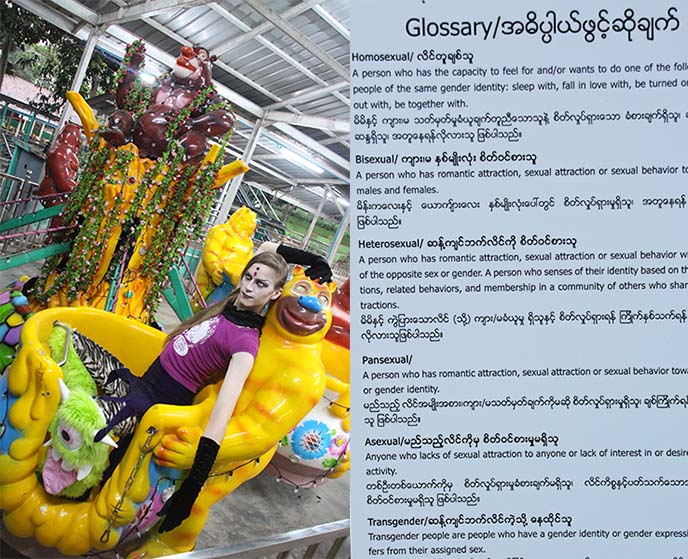
In addition to fighting the discriminatory laws, these LGBT groups are working to increase awareness and education. One giant placard contained a “glossary” with definitions in both English and Burmese. The terms include queer, pansexual and transgender (which are not instinctively known in this population).
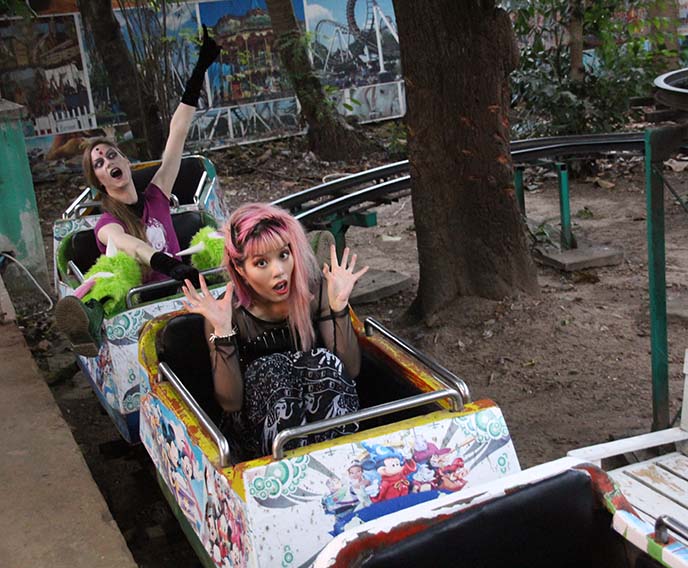
Next to People’s Park, we noticed a creepy abandoned theme park! This is the old “Happy World,” which looks like a derelict, haunted version Disney’s Fantasia. (It should be re-named “Unhappy World,” don’t you think?”
Anyone can access the run-down rides — so naturally, we posed inside the creepy roller-coaster cars. (More images at the end of this article; all photos by Sniper Chau.)

To celebrate Human Rights Day, various Burmese bands took the stage and performed. The Rebel Riot band did an acoustic set with their friends. Between songs, Kyaw Kyaw spoke from the heart about the importance of this cause.
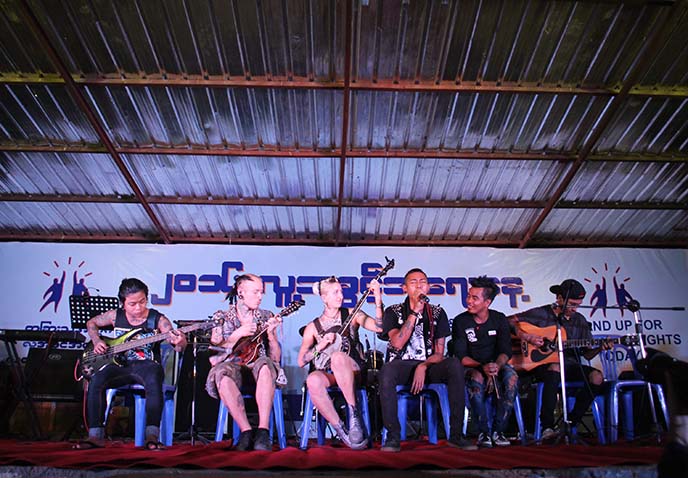
As he put it — he’s an advocate for human rights because as a human being, how could he not be? The fundamental rights to equality, free expression, and protection against unjust persecution should be extended to everyone in society.
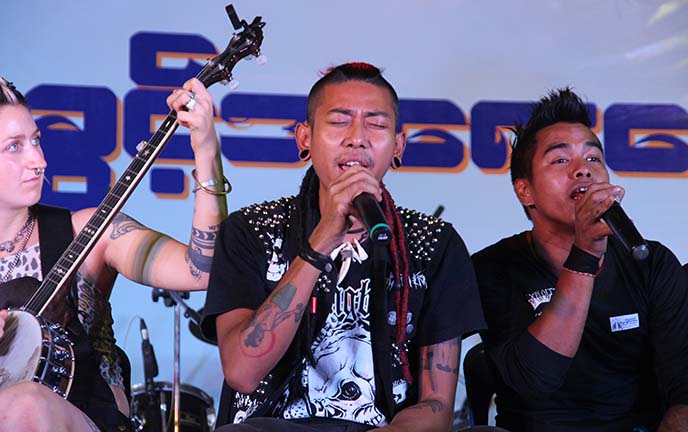
The Rebel Riot’s songs conveyed these messages with power.
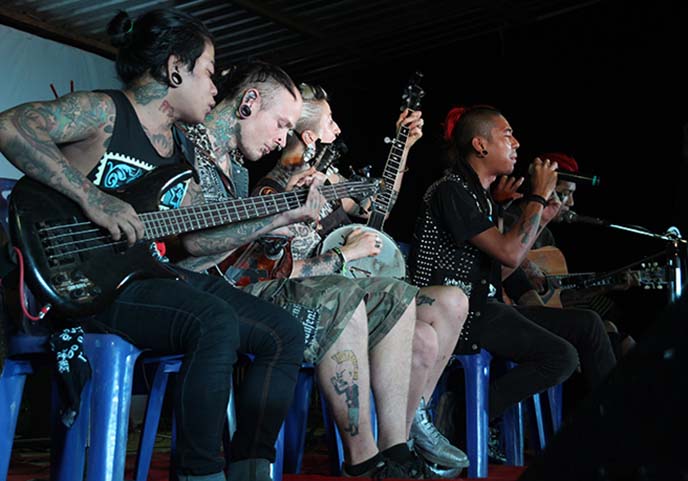
As Kyaw Kyaw’s nonprofits gain more recognition, many are coming to Myanmar to volunteer directly alongside him. My friends and I brought a suitcase full of school supplies for Books Not Bombs, which provides children with educational support (especially in conflict and rural regions of the country).
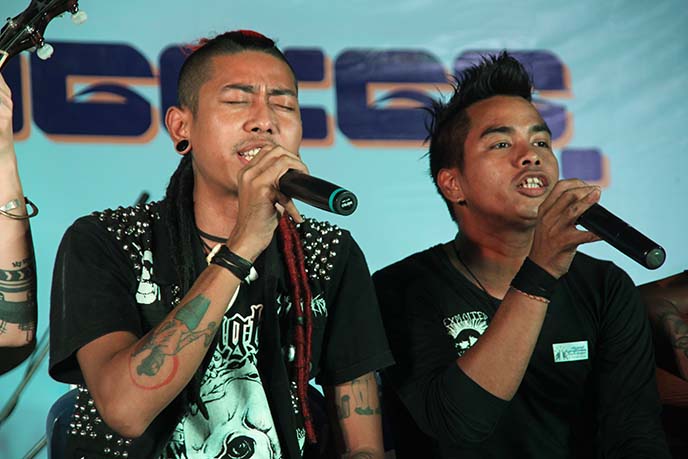
Every Monday night, his group Food Not Bombs purchases food and distributes it to the homeless and needy in Yangon. At first, locals weren’t sure what to make of these tattooed and pierced punk volunteers! However, their dedication spoke for itself, and the rockers are now welcomed each week with hugs.
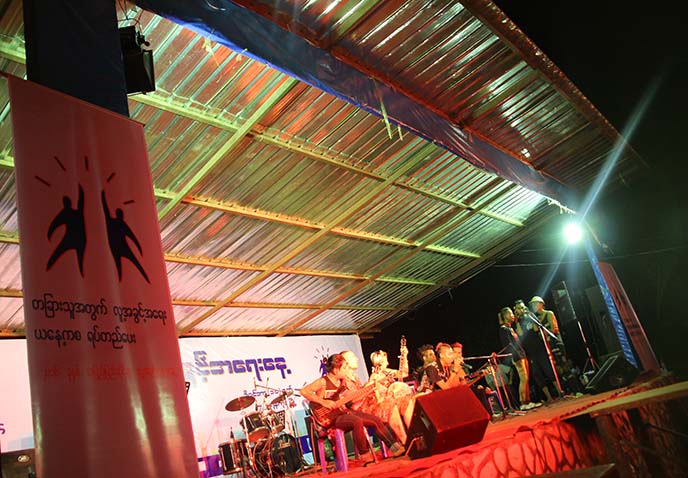
The logo at left (two people giving a high five) summed up the positive spirit of Human Rights Day, Yangon.

In the audience, we saw others with large gauge earrings, alternative dyed and shaved hair, and DIY studded and painted clothing.
It’s interesting (but perhaps not surprising) that punk ideologies have taken hold in Myanmar — as the country has recently broken free of military rule, yet continues to struggle with regional clashes and authoritarianism.

We have full confidence in the young Burmese volunteers we met. They’re progressive and full of energy, and will shape their homeland in a positive, inclusive direction.
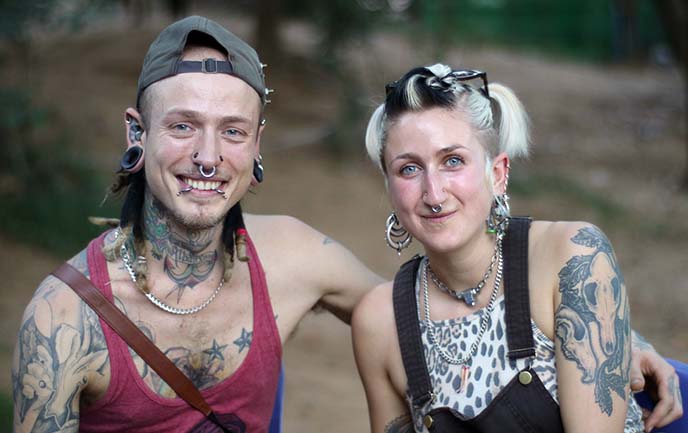
We wanted to get to know The Rebel Riot and friends better, so we made arrangements to hang out the following evening.

It turned out to be a grand gathering of Goths and Punks, at Rangoon Tea House! (Address: Ground Floor, 77-79 Pansodan Rd (Lower Middle Block), Yangon, Myanmar).

We sat down at a long table, and the boys laid out their tattooed arms. I see A for anarchy, hell on the knuckles, a skull, and two gasmasks on these sleeves.
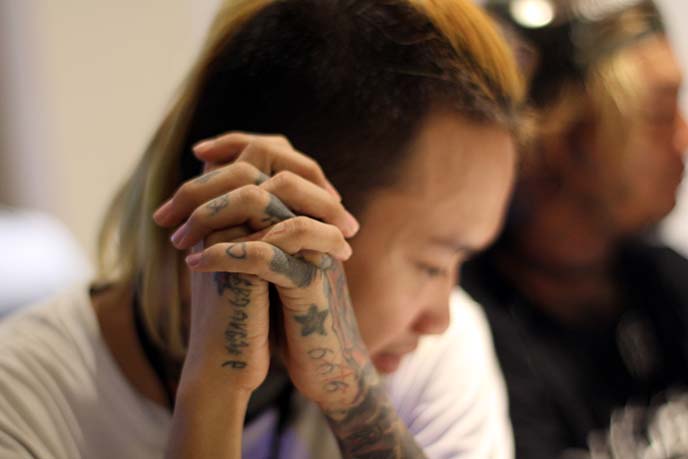
In true punk spirit, many of these tattoos are DIY. I spot 666…
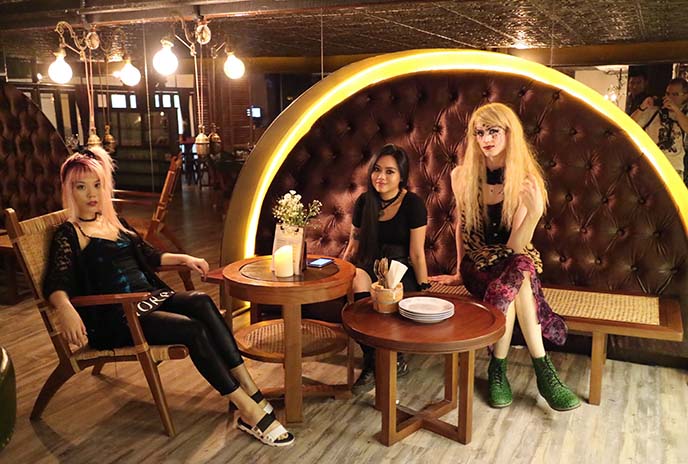
A lot of young locals and travelers come to dine at Rangoon Tea House, which is one of the highest rated restaurants in the city. The restored two-level space is reminiscent of the British colonial era, with classic molded ceilings and lanterns.

Rangoon Tea House is well known for its drink menu. The world-class cocktails are inspired by Asian flavors, such as a jasmine gin and tonic, and “Smoking Cheroot” with smoky cinnamon, bourbon and Hennessy, served on a thanaka tray.
At the entrance, we saw the staff preparing tea from the finest grade pindica leaves, aerated with a long pour from above.

Goths in the back, and punks in the front! I’m standing next to Esther, a Gothic makeup artist, and Ze Ze, vocalist and composer of the band Maze of Mara. We quickly became fast friends — amazing how you can find like-minded spirits in the most unexpected of places.

“System Error” — so good. Tattooing isn’t taboo here, as it is in Asian countries like Korea and Japan. There’s also a history of tattoos among ethnic groups in Burma, up until the 20th century.

As you can see from our smiles, we loved the food at Rangoon Tea House. The mohinga (Burmese fish noodle soup) was so delicious that we ordered two bowls! This national favorite dish is made from fresh Rakhine daggertooth fish, and perfectly balances sweet, sour, salty and spicy.

The menu is a homage to Rangoon’s past — when traders from different countries mingled with colonial settlers and locals. We ate up every bite of the Indian-inspired curries, biryanis, samosas, rotis. Other highlights included British Pimm’s, and traditional Burmese “ohn note kauk” chicken and noodles in coconut broth.

As you can see, the boys were fans of the Burmese beers.

A meal to remember, followed by a night of more laughs, drinks and shenanigans!

On a different evening, we dined at the amazing Yangon Green Gallery — a Thai restaurant that is the favorite hangout of expats and young artistic types. We were sold on the chalkboard sign: “Let us tickle your tastebuds and fill your stomachs.”
Green Gallery Address: Mahabandoola No 58, 52 Street Lower Block, Between Mahabandoola and Merchant, Yangon 1116, Burma.

The friendly owner, Bo, welcomed us with gusto, and insisted that we make ourselves at home. Once again, we found a kindred spirit — we bonded over the 1980s songs that she broadcast all night, from Europe to Eurythmics!

Bo used to live in Thailand, and brought these traditional flavors to her cooking. At the same time, Green Gallery is as modern as it gets: she brought us gin and tonics with colorful straws, and we admired the industrial, bohemian design of the restaurant.

It’s wonderful to see women like Bo put their hearts into their independent businesses, and succeed.

My mouth is watering as I reminisce about our meal at Green Gallery! The menu is simple, with a focus on fresh and healthy — yet comforting — Thailand dishes. The items change with the seasons; we started with spicy salad Larb Mhoo, and adored the panang and green curries with rice. Leave room for the coconut sticky rice and mango dessert, which is full of love.

As you can see, the tables fill up quickly, especially with groups of expats. The restaurant also hosts a monthly Green Party that draws in lots of friendly, young faces.

We could have stayed all night, grooving to the 80s songs and joking with Bo about thumb sizes. There’s no better place in Yangon to get a heart-warming meal than Green Gallery. Please say hi to her for us!
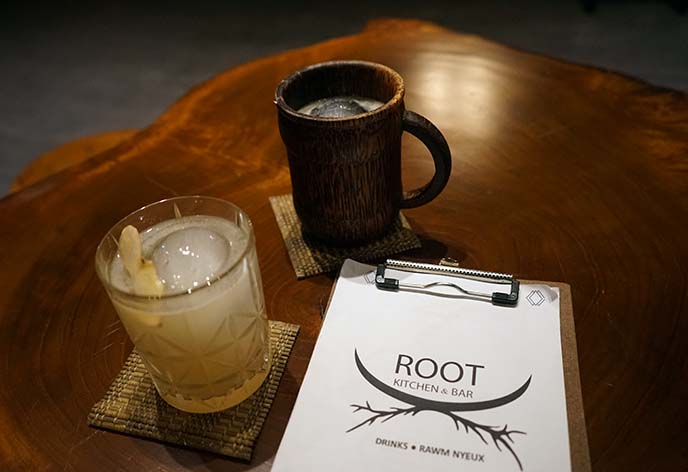
We chatted with someone at the next table, and he suggested that we visit Root Kitchen and Bar for a “Wa-Tang” cocktail. His recommendation was on point: the drinks are perfectly concocted with ingredients like tea, lemongrass, ginger, and a special Wa-region liquor made from rice and barley grains.
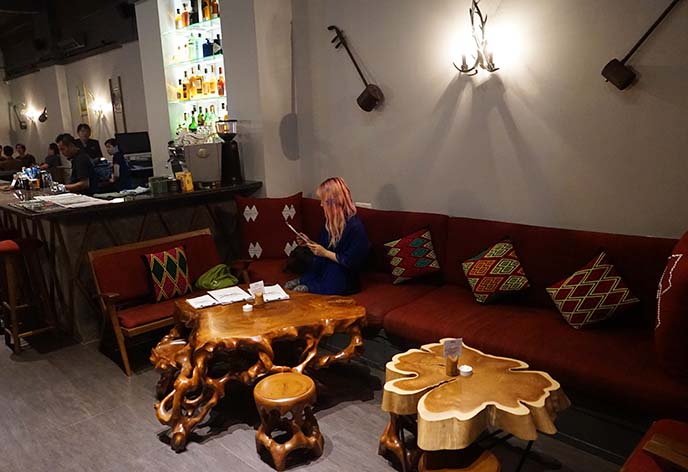
Root is a new restaurant and bar, which pays homage to the Wa people who live in Shan State. This region of Myanmar is often dismissed as a drug and conflict-ridden borderland, so these owners wanted to showcase Wa culture, art, and food in a comfortable space.
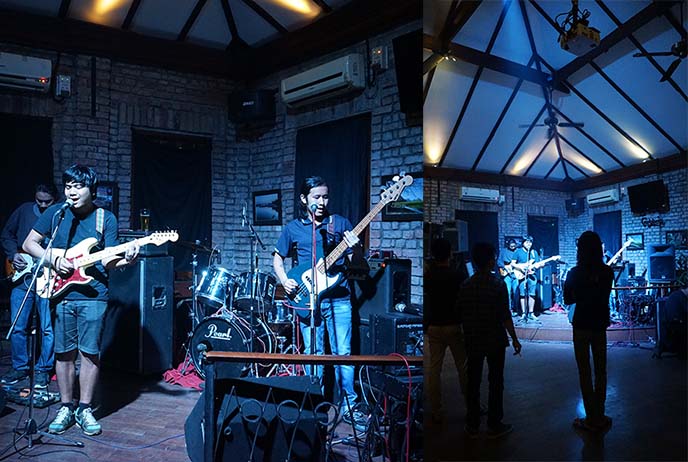
Later, we met Bo and other new friends at the nearby 50th Street Bar (there are lots of bars and hip restaurants in this district). This venue is known for its live concerts — that evening, we watched several alternative bands perform.

 LA CARMINA
LA CARMINA






